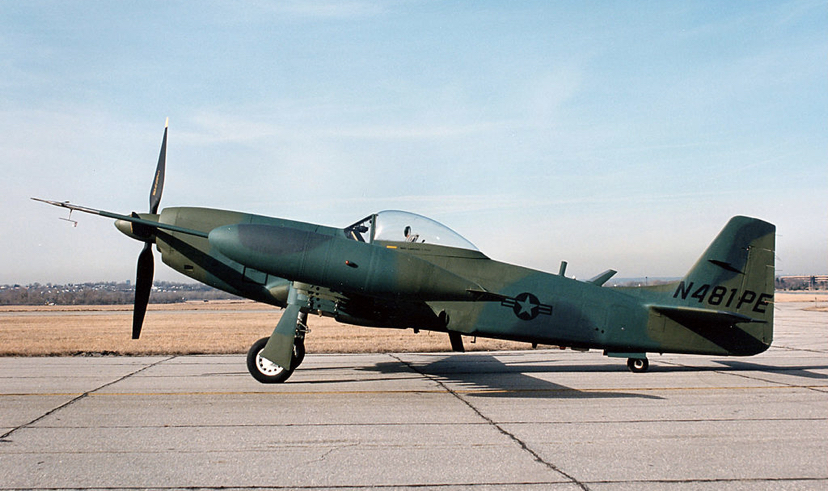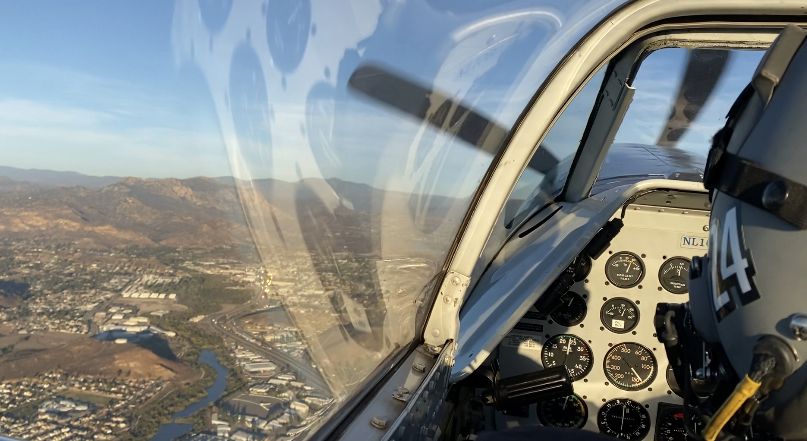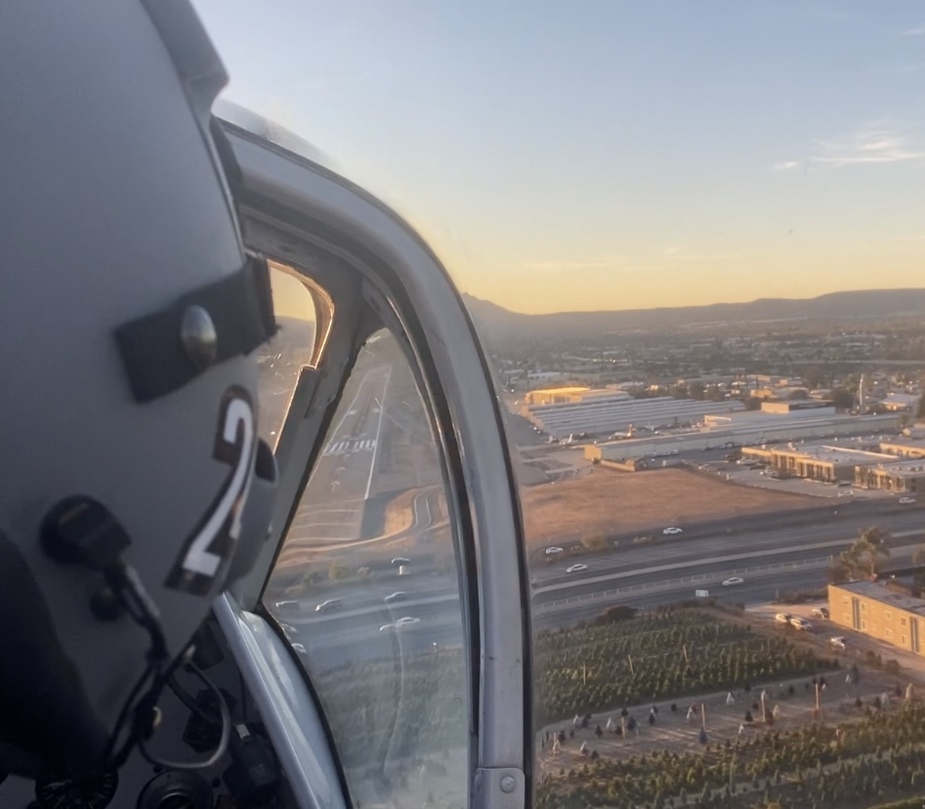It’s a glycol coolant radiator behind and below the cockpit, as pictured in my post #05 above. The radiator has a thermostatically controlled flap that’s closed to warm up the engine and by the time you’ve taxied out and are ready for takeoff on a warmish day, the engine is plenty warm. Prior to that you run the electric pre-oiler pump for four minutes to circulate oil through the engine prior to start up. Then when you start up somebody needs to be standing by with a fire extinguisher in case of a stack fire.
The large diameter coolant pipes running between the coolant radiator and the engine are the source of some of the cockpit heat. It’s not easy or simple to get this kind of power out of any reciprocating aircraft engine but if you have to do so, it’s easy for me to see the appeal of a single row air-cooled radial like North American themselves later used on the T-28. Eventually turboprops came along and were much better at making 1400 HP.
I think this might be the ultimate P-51
Performance-wise probably so, but not looks-wise. I miss that characteristic oil cooler bump down below 
The noise would surely have been better with the right intercom and better specialized headset, not a normal GA setup.
I own and sometimes drive a V12 powered car but based on experience I think this might be the ultimate P-51 

Another friend just finished a long term SNJ restoration (he’s an ex Navy Top Gun pilot so it’s not a T-6  ) and I’d like to try it. His everyday plane is an RV-6 but the T-6 seems to come out about once a month.
) and I’d like to try it. His everyday plane is an RV-6 but the T-6 seems to come out about once a month.
I have a family connection to Supermarine but there aren’t enough of their products around to provide any reasonable opportunity to get in one. I would instead really like like to fly a Messerschmitt Taifun, the predecessor to the BF109. That one was a really advanced plane for its era and also carries four people.
Thanks for the flight review!
I flew the back seat in the Collings P51 N251MX back in 2008. It was incredible fun. I don’t remember it being noisy as you describe, though it was far from quiet. The Merlin is a delight to share a plane with, incredibly smooth. (That year I also took a V12 E-type for a drive – my only V12 experiences and both thoroughly enjoyable).
We did some aerobatics, just basic stuff, loops and rolls. It was delight to handle, as easy as in the Pitts.
Understandably I didn’t get to do the takeoff or landing. Though I did when a flew their B25 a couple of years earlier.
I also got a few flights in a T6. That’s a different story. The engine is noisy with lots of vibration. It’s a bit like flying a tractor, though still loads of fun. It does respectable basic aerobatics. I did do takeoffs and landings, it’s quite a handful to land and keep rolling straight. Actually the hardest part is the primer – once you’re strapped in it’s so stiff that you can’t operate it, so you have to unstrap, prime, then get strapped back in again.
I still dream of riding a Spitfire, there are a couple of places in England. Not sure if I’ll get to it though.
It was for sure an interesting ride. The physical environment for the pilot is much harsher than I had realized. Of course I was in the jump seat, with the usual mess of parachute and harness straps holding me in a position in which my head hit the canopy unless tipped forward slightly. This didn’t help when doing aerobatics (my neck still hurts). Otherwise the noise for anybody on board is just outrageous and there’s a fair amount of vibration too. I’ve only flown one other (experimental) plane where the intercom and headsets are completely overwhelmed on the upwind, making onboard or ATC communication impossible for a while. In level flight the noise diminishes slightly… but if you imagine sitting in a dyno room right next to an engine on full power test while simultaneously trying to fly a plane, that’s a pretty good analogy. There is also a lot of heat coming off the engine and cooling system and the cockpit is hot. I have renewed respect for the people who had to endure that environment for four hours straight 78 years ago, plus thinking clearly and flying in combat at the same time.
On the plus side, I found the P-51 to be a nice handing device. It was easy to roll into a 60 degree + banked turn and hold altitude and turn rate precisely. Its aerodynamically clean, cutting through the air as if on rails and given the high wing loading its very stable. The stall seemed reasonably controllable as I watched it being done, roll off was present but was fixed by getting the wing flying promptly. No drama to maneuver, it just seems to work.
It’s a fairly modern plane powered by a hot, shaking, 80 year old, 27 liter primordial monster of an engine, with short exhaust stacks directing dragster level noise straight at you. Turboprops and jets came along at the right time for high power applications 
Wow. That’s quite a ride.
I just turned zinc chromate green with envy 
I finally got my back seat stick time in the P-51. As one might expect it is an unbelievably loud experience, like flying with the hammers of hell and I barely fitted in the back seat, in the latter regard very much like an RV-8  I was able to find it flies very nicely in the basic maneuvers I performed, steep turns, normal climb and descent. Very direct, solid, no nonsense was my impression. This was just after takeoff, climbing at 140 mph.
I was able to find it flies very nicely in the basic maneuvers I performed, steep turns, normal climb and descent. Very direct, solid, no nonsense was my impression. This was just after takeoff, climbing at 140 mph.

My friend the real P-51 pilot demonstrated some aerobatics and a couple of stalls. He says it’s great for aerobatics except you need three times the space that a light aircraft needs. We then landed with an I’d guess 3G overhead break and tight circle to the threshold.

A great experience despite my ears still ringing and chest still reverberating like I’d been front row of a heavy metal concert for 30 days in row. I don’t know how wartime pilots could fly these every day.
We burned 40 gallons of 100LL on our short flight, fuel flow on takeoff is something to see.
Yes, the Spitfire was designed like a homebuilt in the sense that it was not heavily tooled up, all hand made. Take a look at the multiple square tubes, inserted snugly concentric with each other, that form the Spitfire wing spar caps. The idea was the cap is effectively tapered by ending the individual tubes at different stations along the wing. Take two of those concentric square tube assemblies, attach them to a shear web, and you have a wing spar, one made of a great many pieces.
A relative worked at Supermarine from 1945 to 1957 or so, and I heard a lot of stories. The aluminum fairings were made by hand, even the saddle shaped fairing at the root of the vertical tail.
Something like the Mustang, apparently the Bf-109 (I’m not greatly familiar with the design although I’m following Kermit Week’s Taifun project closely on UT) and I think even the RVs is built in a more ‘tooled up’ way.
Silvaire wrote:
Those are built differently with a higher parts count.
The Bf-109 has allegedly only 1/3 of the part count compared with a Spitfire  Regarding maintaining one today, I think the Spitfire is relatively easy because it was designed essentially as a homebuilt, few special tools required, and few parts that cannot easily be made.
Regarding maintaining one today, I think the Spitfire is relatively easy because it was designed essentially as a homebuilt, few special tools required, and few parts that cannot easily be made.